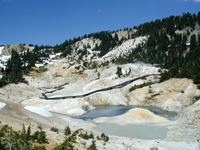 | ||
Similar Lassen Peak, Manzanita Lake, Cinder Cone, Mount Tehama, Drakesbad Guest Ranch | ||
Geothermal areas in lassen volcanic national park sulfur works
The geothermal areas in Lassen Volcanic National Park include several groups of hot springs and fumaroles, as remnants of former volcanic activity, exist in Lassen Volcanic National Park. Most of these lie in or are closely adjacent to Mount Tehama's caldera. Bumpass Hell is the most spectacular of these, but others of importance are Sulphur Works, Little Hot Springs Valley, Boiling Springs Lake and Devil's Kitchen. In each thermal area, the highest temperature of water generally is close to the boiling temperature at the altitude of the particular spring or fumarole—198 °F (92 °C) at Bumpass Hell and 191 °F (88 °C) on the northwest flanks of Lassen Peak. Temperatures as high as 230 °F (110 °C) have been recorded in the park.
Contents
- Geothermal areas in lassen volcanic national park sulfur works
- Bumpass hell geothermal areas in lassen volcanic national park august 2011
- Sulphur Works and Little Hot Springs ValleyEdit
- Bumpass HellEdit
- Devils KitchenEdit
- Terminal GeyserEdit
- Boiling Springs LakeEdit
- References
Spring activity varies with water supply. Abundant water results in clear springs during early summer, but as the season progresses and the water supply decreases, springs change successively to turbid, warm pools, spattering mudpots, and finally steaming fumaroles. There are no true geysers within Lassen Volcanic National Park.
Gases from hot springs are composed mostly of steam and carbon dioxide, with minor amounts of other gases. These react with the rocks around the springs to ultimately form opal if temperature and acidity are high, and kaolin if they are low. Deposits of sulfur, pyrite, quartz and other substances are also found around the springs and in their runoff channels.
Solfataric alteration within the caldera of Mount Tehama covers about five square miles, much more extensive than the present hot springs basins—indicative of its former extent, and suggestive of its waning activity. It is the altered materials in the caldera which yielded most readily to the forces of erosion. Diamond Peak is a body of unaltered rock which still remains because it is more resistant.
Bumpass hell geothermal areas in lassen volcanic national park august 2011
Sulphur Works and Little Hot Springs ValleyEdit
As in many hydrothermally active areas, the rocks at Sulphur Works and Little Hot Springs Valley in Lassen Volcanic National Park have been chemically altered into bright-colored clays. Sulfurous acid and sulfuric acid have broken down hard, gray-green andesite lavas into red, yellow and buff clays and iron oxides. Many visitors pass through Sulphur Works on their way north on State Route 89 and sense the rotten-egg smell (hydrogen sulfide) when they pass by a hot vent to the east of the road. Sulphur Works is said to be the volcanic center of the ancestral Mount Tehama.
Bumpass HellEdit
Near Little Hot Springs Valley is Bumpass Hell, which is a hydrothermally altered geothermal area that spans 16 acres (65,000 m²) and has hot springs, fumaroles, and boiling mud pots. Never part of Mount Tehama's main vent, Bumpass Hell is the result of fissures that tap the volcanic heat (which is thought to be a cooling mass of andesite, perhaps three miles (5 km) below the surface)
It is named after Kendall Vanhook Bumpass, a miner who worked in the Lassen area in the 1860s. K.V. Bumpass discovered the area and was named on a mining claim for the area. In 1865 the editor of the Red Bluff Independent newspaper took a trip with Bumpass to see the locale. During this trip K.V. Bumpass broke though a thin crust above a boiling mud pot, his leg was badly scalded and eventually had to be amputated. The area was named in his honor.
Devils KitchenEdit
About 7 mi (11 km) southeast of Lassen Peak is Devils Kitchen. In this geothermal area the hot springs are so acidic that they have eaten pits and holes in the bedrock.
Terminal GeyserEdit
Located in the southeast corner of the park, Terminal Geyser is not actually a geyser, but rather a cold stream flowing over a steam vent. This is about 100 feet (30 m) from the site of a geothermal drilling operation that took place in 1962 and 1978. The 4,008-foot (1,222 m) well is now plugged and abandoned.
Boiling Springs LakeEdit
Just northwest of Terminal Geyser, large, warm-water Boiling Springs Lake has many hot springs, mudpots, and fumaroles along its west shore. Unlike the more heavily visited areas of the park, this area is not developed with boardwalks or signs and offers a chance to view thermal features in a more natural setting.
